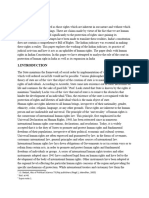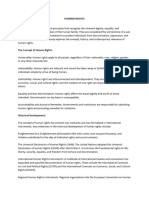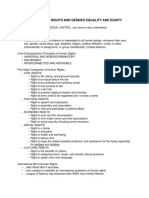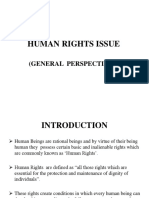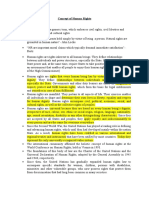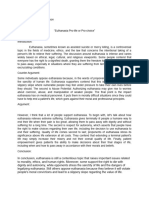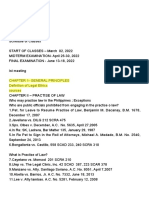Lecture 1 Notes
Course Title: Human Rights and Emerging challenges in the Context of Public
Administration and Policy Development
Course Level: 3rd Year, 2024/2025
Course: Public Administration and Policy Development
Topic: Introduction to Human Rights and Human Rights Issues
Introduction to Human Rights
Human rights are the fundamental rights and freedoms that every individual is entitled to, simply
by virtue of being human. These rights are inherent, inalienable, and universal, meaning they apply
to all people regardless of their nationality, ethnicity, religion, gender, or any other status.
Human rights serve as a foundation for justice, equality, and freedom across the globe. They are
designed to protect the dignity of individuals and ensure that people are treated with respect,
fairness, and equality.
Public administration and policy development must be closely aligned with human rights
principles to safeguard these rights within governance structures and across societies.
1. The Concept of Human Rights
Human rights can be understood through several key concepts:
Universality: Human rights are universal, applying to all people everywhere. They are not
determined by nationality, race, or culture.
Inalienability: Human rights cannot be taken away, though they may be restricted under
specific circumstances (such as during wartime or in cases of criminal activity).
Indivisibility: Human rights are interdependent and indivisible. Civil, political, economic,
social, and cultural rights all have equal importance.
Equality and Non-Discrimination: All individuals are entitled to their human rights
without discrimination of any kind.
Human rights include both civil and political rights (such as the right to free speech and the right
to a fair trial) and economic, social, and cultural rights (such as the right to education, healthcare,
and an adequate standard of living).
2. The Development of Human Rights
The modern human rights movement traces its origins to the aftermath of World War II, with the
formation of the United Nations (UN) and the adoption of the Universal Declaration of Human
Rights (UDHR) in 1948. This document, adopted by the UN General Assembly, is a milestone in
the development of human rights law and has influenced various international treaties and national
constitutions.
�Key milestones in the development of human rights include:
The Universal Declaration of Human Rights (1948): A historic document that articulates
the basic rights to which all human beings are entitled. It covers a broad range of civil,
political, economic, social, and cultural rights.
International Human Rights Treaties: Several international treaties were adopted
following the UDHR, such as:
o International Covenant on Civil and Political Rights (ICCPR) (1966)
o International Covenant on Economic, Social, and Cultural Rights (ICESCR)
(1966)
o Convention on the Elimination of All Forms of Racial Discrimination (CERD)
(1965)
o Convention on the Elimination of All Forms of Discrimination Against Women
(CEDAW) (1979)
o Convention on the Rights of the Child (CRC) (1989)
These treaties are legally binding for states that sign and ratify them, ensuring the protection of
specific human rights and imposing obligations on governments to uphold them.
Regional Human Rights Frameworks: In addition to global instruments, various regions
have established human rights frameworks, such as:
o The European Convention on Human Rights (ECHR).
o The African Charter on Human and Peoples' Rights.
o The American Convention on Human Rights.
3. The Role of Public Administration in Human Rights Protection
Public administration plays a critical role in the realization and protection of human rights through
policy development, implementation, and enforcement. The role of public administrators in
promoting human rights includes:
Policy Formulation: Public administrators are responsible for crafting laws and policies
that align with human rights principles, ensuring that civil, political, and socioeconomic
rights are protected within government operations.
Human Rights Monitoring and Accountability: Public administrators must oversee
compliance with human rights standards within government actions and institutions. This
includes ensuring that individuals have access to remedies when their rights are violated,
such as the right to appeal unlawful detention.
Advocacy and Education: Governments and public administrators are often tasked with
raising awareness about human rights within society and promoting education on the
importance of human rights protections.
International Cooperation: Public administrators must engage with international human
rights organizations and mechanisms (such as the UN Human Rights Council) to
strengthen human rights standards globally and contribute to international efforts in human
rights advocacy.
�4. Human Rights Issues in Contemporary Society
Human rights issues remain a major focus for global governance, as various challenges continue
to arise. Public administrators and policymakers face numerous issues regarding the protection of
human rights, including:
A. Poverty and Economic Inequality
Poverty remains one of the largest human rights issues, as it affects people's ability to exercise
their economic, social, and cultural rights. Inequality in wealth distribution often leads to violations
of the right to an adequate standard of living, healthcare, and education.
Challenge: Economic inequality often leads to the denial of basic rights such as food,
shelter, and access to healthcare.
Policy Response: Governments need to implement social safety nets, economic policies
that promote wealth redistribution, and ensure access to quality public services.
B. Discrimination and Inequality
Discrimination based on race, gender, religion, sexual orientation, disability, and other factors
remains prevalent in many parts of the world, violating the principles of equality and non-
discrimination.
Challenge: Inequalities faced by marginalized groups such as women, racial minorities,
LGBTQ+ communities, and persons with disabilities.
Policy Response: Enacting anti-discrimination laws, affirmative action policies, and
fostering inclusion within public and private sectors.
C. Refugees and Forced Migration
Millions of people worldwide are forced to leave their homes due to conflict, persecution, and
environmental disasters. Refugees and migrants often face discrimination and lack of legal
protection.
Challenge: Refugees often face denial of the right to asylum, inadequate living conditions
in camps, and lack of integration opportunities in host countries.
Policy Response: Public administrators must ensure compliance with international refugee
laws (e.g., the 1951 Refugee Convention) and develop policies for the protection and
integration of refugees.
D. Gender Inequality and Violence Against Women
Despite progress, gender inequality remains a significant issue globally. Women continue to face
violence, discrimination in employment, unequal access to education, and limited participation in
political processes.
� Challenge: Gender-based violence (GBV), including domestic violence, sexual
harassment, and human trafficking.
Policy Response: Public policies should include laws protecting women from GBV,
ensuring equal access to education and employment, and promoting women’s political
participation.
E. Digital Rights and Privacy
In the digital age, new human rights issues have emerged, particularly concerning privacy, freedom
of expression, and data security.
Challenge: State surveillance, censorship, and the infringement on privacy through digital
platforms.
Policy Response: Enacting laws to protect digital privacy, ensuring free access to
information, and safeguarding individuals' rights online.
5. The Role of Public Policy in Addressing Human Rights Issues
Public policies are essential in addressing human rights issues effectively. Governments must
design policies that promote:
Protection of Civil Rights: Ensuring that individuals have the freedom to express
themselves, practice their religion, and live without fear of arbitrary detention or
persecution.
Social and Economic Rights: Promoting access to education, healthcare, housing, and
employment, which are essential for realizing human dignity.
Strengthening Accountability: Holding governments accountable for human rights
violations and providing accessible mechanisms for citizens to report and seek redress for
violations.
International Human Rights Collaboration: Engaging in international agreements and
frameworks that promote human rights globally, and cooperating with international bodies
such as the United Nations and regional human rights organizations.
Revision Questions
1. What is the concept of human rights, and what are the key principles that guide human
rights protection?
2. How did the Universal Declaration of Human Rights (UDHR) contribute to the global
human rights framework?
3. What role does public administration play in promoting and protecting human rights?
4. Discuss the main human rights challenges that public administrators must address in the
contemporary world.
5. How can public policies address poverty, economic inequality, and their impact on human
rights?
6. What are the key challenges related to the protection of refugees and forced migrants, and
what strategies can be adopted by public administration to address them?
�7. How can public policy help combat gender inequality and violence against women?
8. What is the significance of digital rights in the context of human rights, and what policies
should governments adopt to protect privacy and freedom of expression online?



















